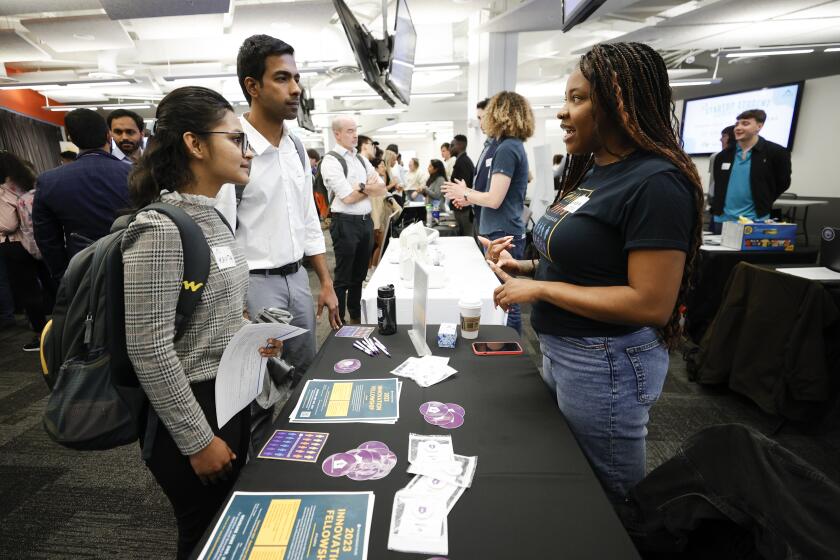Why pushing STEM majors is turning out to be a terrible investment

- Share via
Republicans and Democrats don’t seem to agree on much these days. But despite the gridlock in Congress, both political parties have for years supported spending billions on Science, Technology, Engineering and Math (STEM) education. Their goals include reducing perceived shortages of STEM workers, boosting American innovation and competitiveness and diversifying this highly paid workforce. The message of lucrative STEM careers appears to have reached students and tuition-paying parents — the number of STEM majors has surged in recent years.
But there is a problem with these massive investments: Most STEM graduates don’t work in STEM occupations. The Census Bureau reported in 2021 that a paltry 28% of STEM grads are working in these supposedly in-demand, highly paid and important STEM jobs. These include diverse sectors such as pharmaceuticals, chemicals and energy, but about half of STEM jobs are in computers, and tech firms typically complain the loudest of STEM shortages.
The recent mass layoffs at Google, Microsoft, Amazon and Meta came as a shock to thousands of workers who’d never experienced upheaval in the tech sector.
What’s causing this disconnect? It’s pretty straightforward: Employers, and the investors who drive their behavior, depress the national returns on STEM education investments.
One key factor is wages. Many able STEM grads bolt for better-paying careers, especially in business, finance, management and medicine (government programs focused on STEM exclude medical practitioners and are not designed to increase those numbers). Some do find high salaries in STEM jobs, many right out of college, especially in hot fields such as AI. But STEM grads even in the most dynamic sectors, including computer science and engineering, see their salary advantage fade over time, increasing the odds that they’ll leave for greener pastures.
It is employers, of course, who set wages at their firms, and current wage levels are not keeping most STEM grads in STEM jobs. Some of the wealthiest companies — Apple, Google, Adobe Systems and Intel — settled a class-action lawsuit for $415 million in 2015 after workers alleged employers used illegal means to prevent salary increases. Employers also incentivize moves from technical work to management with higher salaries at their own firms, yet many bemoan a shortage of technical STEM workers, not managers.
STEM grads may also flee the “burn-and-churn” management common in STEM jobs. We’ve been bombarded by images of young, happy-go-lucky STEM workers playing foosball and skateboarding to free snacks or meditation pods. But the more common experience, especially in tech, is grueling “crunch time” to rush a product out the door while worrying about the next performance review.
Universities were never meant to be merely career-prep schools. But more universities are shrinking non-STEM departments.
Media accounts of the most famous companies describe workplaces that are aggressive, both for employees and for the “shadow workforce” toiling on short-term contracts. This work stress affects both physical and mental health. Employees at Uber, Facebook and Google have taken their own lives, prompting discussion of the role of workplace culture in their deaths.
Adding to the stress is the constant threat of layoffs. Even the richest firms regularly shed STEM workers as technologies or markets change or investors demand cost reductions. When Elon Musk took over Twitter and sacked more than half the workforce, other CEOs cheered. Musk was hardly a STEM trailblazer; workers in the high-demand field of IT are more likely to face layoffs than workers in most other industries. Especially vulnerable are expensive older workers and those who didn’t, or couldn’t, self-train to keep their skills relevant — an increasingly important practice because employer-provided training has dwindled over recent decades.
Employers facing STEM shortages should bend over backwards to keep their scarce talent. Instead, research finds that STEM employers maintain unwelcoming environments for older workers as well as women and underrepresented minorities. Sheryl Sandberg, the former COO of Facebook (now Meta), blamed Facebook’s dearth of female software developers on universities and society for not graduating more female computer science and engineering majors. But why would women choose a sector where the numbers indicate they aren’t welcome? Where even blatant sexual harassment can go unpunished?
Some STEM grads also reject STEM jobs because so many are meaningless or even harmful. Workers have fled social media companies following concerns that they spread misinformation, erode democracy and foster teen depression. Fossil fuel companies struggle for STEM talent due to their damage to the planet. Trillion-dollar tech companies are often accused of unfair trade practices and “surveillance capitalism” that mines users for personal data. STEM grads who want to make the world a better place may struggle to find a fit.
The poor return on investments in STEM education can improve. Employers facing STEM worker shortages must understand that their wounds are self-inflicted. They can raise wages, utilize worker-friendly management, re-train obsolete workers rather than lay them off, follow best practices on workplace inclusiveness and eschew destructive business models.
But investors repeatedly reward employers for treating STEM grads like fast fashion — discarded when broken or no longer appealing — or for deploying STEM skills in lucrative yet harmful business models. A better return on STEM education will require corporations to move away from maximizing short-term shareholder value and consider more stakeholders and moral limits on money making. Meanwhile, governments can lure investors to put more money in planet-saving technologies, as Congress did with the Inflation Reduction Act.
Without these or similar shifts, STEM majors will continue to be oversold.
John D. Skrentny is the author of “Wasted Education: How We Fail Our Graduates in Science, Technology, Engineering and Math” and a professor of sociology at UC San Diego.
More to Read
A cure for the common opinion
Get thought-provoking perspectives with our weekly newsletter.
You may occasionally receive promotional content from the Los Angeles Times.











